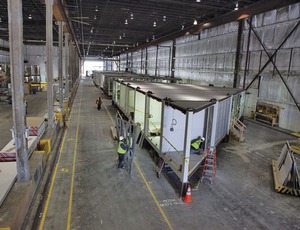
Things are beginning to stack up nicely at the 100,000-sq-ft assembly plant for the latest far-out adventure of developer Forest City Ratner Cos.—modular high-rise residential construction. On Nov. 1, the first 27 of 930 modules moved off the line for FCRC's 32-story B2 Bklyn tower at the nearby Atlantic Yards development.
Last month, there was another modular milestone: a successful trial stack. "We passed a water test for the seals between the modules," says Susan Jenkins, head of operations at the Brooklyn Navy Yard plant for the year-old modular-high-rise business, an equal joint venture between Forest City Ratner Cos. and Skanska USA Building Inc., called Forest City+Skanska Modular.
The low-rise work in the plant, half of which looks like a Home Depot and the other half an ordinary workshop, belies the complexity of the planning and negotiations that went into making the project happen. Modular building is a big adjustment for the building team because it changes the sequencing of both design and construction.
For starters, the project was the catalyst for the formation of a modular division within the Building and Construction Trades Council of Greater New York, which represents local unions. In a major departure from the norm, the division allows crews from many different trades—electricians, plumbers, ironworkers, carpenters, painters and more—to work together in multi-trade teams.
That's not all. B2 modules have structural-steel chassis. Modular construction introduces different details than are customary, according to Don Banker, CEO of the steel contractor, Banker Steel. And crews have to build the chassis to much stricter tolerances.
Even more significantly, starting in January, Banker's ironworkers will have to transport the finished modules—complete with everything, including the kitchen sink and windows—to the B2 site and erect them without damage. "First, I'm a fabricator delivering chassis from Virginia to Brooklyn," says Don Banker. "Soon, I will be handling modules with kid gloves, stacking them on-site. It's foreign to us."
When Jenkins, also a Skanska vice president, arrived at the plant in June, she was skeptical of the idea of modular-high-rise residential, in which 60% of the building is shop-assembled. Once she understood the engineering developed for it and saw the speed at which modules can be constructed, she became a believer. "This is really cool, being exposed to something as innovative as modularization,"Jenkins says.










Post a comment to this article
Report Abusive Comment